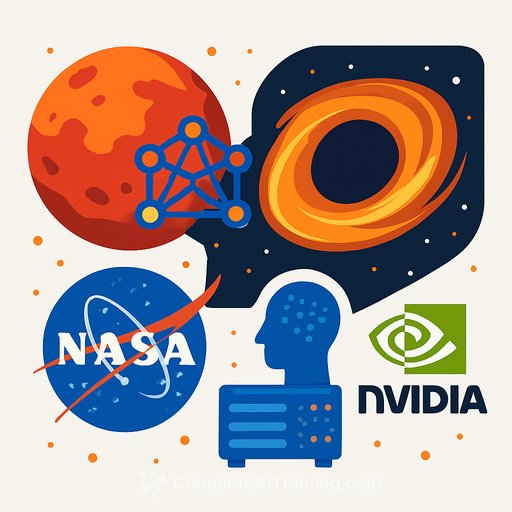NASA & Nvidia: Deep Learning That Moves Science Forward
From a Mars simulation in 2003 to GPU-accelerated AI at scale, NASA and Nvidia have built a model for applied research: match big data with the right compute, and push for real-time results. For scientists, the lesson is simple-algorithms matter, but infrastructure decides the pace of discovery.
From graphics to scientific compute
Nvidia started as a graphics company in 1993. The pivot came into focus when NASA asked for a photorealistic Mars simulation in 2003-proof that graphics hardware could run serious science.
In 2006, CUDA opened up GPUs for general computing. By 2012, AlexNet trained on Nvidia GPUs reset benchmarks on ImageNet, signaling what Nvidia's CEO later called the start of a new industrial era. Early adopters like NASA saw what this meant for missions flooded with sensor and satellite data.
Deep learning, in brief
Deep learning uses stacked neural networks to find patterns in large datasets and improve through exposure, not explicit rules. It moved from theoretical promise to practical engine as GPUs made training viable at the scale science demands.
Case study: DeepSat monitors Earth's vital signs
Monitoring climate from orbit breaks traditional pipelines. NASA built DeepSat to classify and segment satellite imagery at scale-not for pretty pictures, but for carbon, vegetation, and climate insights.
Training spanned 330,000 scenes across the continental US. Average tiles were 6,000 by 7,000 pixels (~200 MB each), totaling ~65 TB for a single time epoch at 1 m resolution. Sangram Ganguly reported a 97.95% classification accuracy, beating three state-of-the-art object recognition methods by 11%.
Outputs feed estimates of carbon sequestration, downscale climate variables, and quantify urban heat islands. Nvidia Tesla GPUs and the NASA Ames Pleiades Supercomputer (217,088 CUDA cores) cut training from months to days or weeks, turning long-term studies into operational analytics.
Case study: LIGO detects gravitational waves in real time
LIGO's challenge: find faint gravitational-wave signals buried in noise, fast enough to coordinate telescopes worldwide. Daniel George and Eliu Huerta at the NCSA Gravity Group built deep CNNs on Nvidia Tesla GPUs to detect signals and estimate black hole masses with strong precision.
As Dr. Eliu Huerta put it: "Gravitational wave astrophysics is a multidisciplinary effort. At NCSA we combine our expertise in HPC, HTC, analytical and numerical gravitational wave source modeling. Then we boost it with innovative applications of AI to push the frontiers of the field. Our partnership with Nvidia is a key element in our daily research activities."
Their approach improved AI inference speed by 100x, with GPU acceleration adding another 50x-over three orders of magnitude faster overall. That made real-time detection practical and accelerated multi-messenger astrophysics. For background, see LIGO.
The modern era: Scaling scientific AI
NASA now runs GPU hackathons across centers, improving CFD and AI workloads by 40% up to 250x. The agency adopted Nvidia's RAPIDS libraries to accelerate data science for atmospheric chemistry and air quality forecasting.
At NASA's Global Modeling and Assimilation Office, Christoph Keller uses ML to approximate chemical transformations, cutting the cost of running models like GEOS-CF that simulate ~250 species in near real-time. And as David Salvagnini, NASA's Chief Data Officer and Chief AI Officer, notes: "AI has been very involved in the use of AI and ML - helping in the discovery of exoplanets and planetary exploration, including autonomous systems such as the Mars Perseverance Rover."
Infrastructure matters: Open multimodal AI for science
The partnership is now infrastructure-level. The US National Science Foundation and Nvidia are funding the Open Multimodal AI Infrastructure to Accelerate Science (OMAI), led by the Allen Institute for AI: US$75M from NSF and US$77M from Nvidia. The goal: broad access to capable models that scientists can adapt to domain problems.
As Nvidia's CEO framed it, AI is now a core engine for modern science-and open models for researchers will drive the next industrial upswing. Learn more at the National Science Foundation.
Looking beyond Earth: Space-based computing
The next step is compute in orbit. In collaboration with NASA and the US Department of Defense, companies including HPE, Nvidia, IBM, and SpaceX are advancing radiation-tolerant servers, AI-driven automation, and HPC for on-orbit processing.
David Salvagnini points to orbital debris as a priority, with AI helping detection and cleanup planning. The strategy is clear: process data near the sensor to avoid latency and bandwidth limits, and send down distilled results instead of raw feeds.
What research teams can apply now
- Prioritize workloads where latency matters: event detection, anomaly screening, and instrument control. Push inference to the edge when bandwidth is tight.
- Adopt GPU-accelerated data science stacks (e.g., RAPIDS) to remove Python bottlenecks and keep end-to-end workflows on the GPU.
- Build training sets that match operational reality-image sizes, noise profiles, and temporal cadence-not just benchmark datasets.
- Use hybrid modeling: couple ML surrogates with physics codes to reduce runtime while preserving scientific fidelity.
- Plan for MLOps early: version data and models, monitor drift, and budget for retraining as instruments or environments change.
From climate mapping with DeepSat to real-time gravitational-wave alerts, the NASA-Nvidia story shows a repeatable pattern: pair ambitious data with the right compute, and target real-time whenever possible. As Dr. Huerta said, "Making real-time analysis possible is the key to realising multi-messenger astrophysics." The same principle applies across Earth science, heliophysics, planetary, and beyond.
If your team is building GPU-accelerated AI capabilities for scientific work, explore role-specific training options at Complete AI Training.
Your membership also unlocks:






